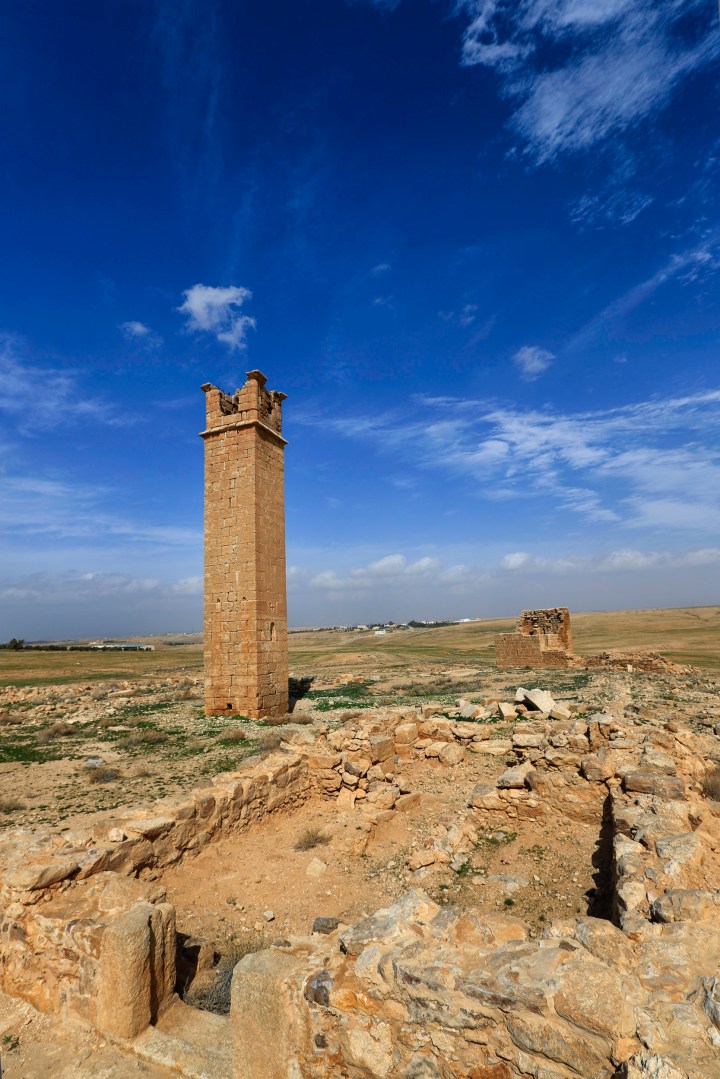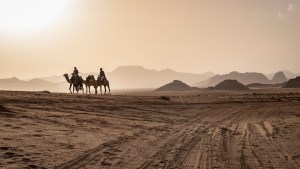The Jordan Trail is a 700-kilometer hiking route crossing all of Jordan, from north to south. It is the Holy Land-based equivalent of the Camino de Santiago or the Via Francigena, yet with an important difference: whereas the Camino covers a number of medieval routes associated with one of Jesus’ apostles (namely, James the Great,) the Jordan Trail covers more than three thousand years of biblical tradition and history, and includes an important number of holy sites for all Abrahamic religions.
The Trail begins (or ends) by the shores of the Red Sea. It follows the path that tradition claims Moses walked, goes through the areas where the prophet Elijah lived and ministered, reaching Jesus’ Baptism site and the places where John the Baptist preached and was martyred. For those who don’t shy away from combining pilgrimage, devotion, adventure, and even a healthy dose of extreme sports, the trail is a dream come through. On foot (although mules, jeeps, camels, and other means of transportation are available in different parts of the trail,) the ideal full route takes at least a good biblical 40 days —enough time to cross 52 villages, four different kinds of landscapes (from red sand cold deserts to fertile green valleys with thermal waters), and several ancient pilgrimage and trade routes.

Considering how Jordanian history is deeply intertwined with biblical tradition, it is no wonder that these routes abound with ruins of ancient biblical towns, or that they are basically paved with the remains of early Christian Byzantine basilicas, like those of Tel Mar Elias, Umm Al Jimal, or the impressive church of Saint Stephen in Umm Al-Rasas, which even includes a stylite tower. Some other ancient basilicas are still in use, and have been carefully rebuilt, preserving most of their original mosaics and decorations. They are among the most impressive, ancient, and interesting churches in the Holy Land. Here, we wanted to share some of the most significant ones, which you must visit in your coming trip to Jordan.
1. Memorial Church of Moses
Biblical tradition (and extra-biblical sources as well) maintain Moses walked across Jordan, from the shores of the Red Sea in the south, all the way to the north to Mount Nebo. Deuteronomy tells the story of how Moses ascended to the top of the mount, where “the Lord showed him the whole land — from Gilead to Dan, all of Naphtali, the territory of Ephraim and Manasseh, all the land of Judah as far as the Mediterranean Sea, the Negev and the whole region from the Valley of Jericho, the City of Palms, as far as Zoar,” and then died there, “in Moab” —that is, today’s Jordan.
Moses’ burial place, Deuteronomy goes on, is unknown. But a monument high atop Mount Nebo commemorates his death after seeing the whole Jordan valley: a sculpture by Italian artist Giovanni Fantoni, representing Moses’ brazen serpent and Jesus’ cross (Cf. Numbers 21:4–9) The sculpture is recent, but the place has been a pilgrimage destination since the fourth century: a Christian church from Byzantine times once stood there, and its richly adorned mosaic floor and columns are still preserved in the sober new church —the “Modern Memorial of Moses.”

When the ancient church was excavated (between 1933 and 1938) the basilica, its different chapels, and the annexes of a monastery that had been built in the mount were brought to light. The exquisite mosaics that can be seen today were then first discovered, and a sustained effort to preserve them was started, and continued until the new modern basilica was finished, back in 2007. While the complex didn’t finally reopen to visitors until October 2016, the place was visited by Pope John Paul II and Benedict XVI on their visits to the Holy Land in 2000 and 2009 respectively.

2. First and Modern Churches of Saint John the Baptist
Al-Maghtas (meaning “immersion” and, by extension, “baptism” in Arabic) is the name given to the place that has been considered since Byzantine times, to be the original location of the Baptism of Jesus. It is also the area where John the Baptist lived and ministered, and where tradition claims the Prophet Elijah was assumed into Heaven. Al-Maghtas, also known as Bethany-Beyond-the-Jordan, is clearly thick with layers and layers of thousands-year-long biblical references, traditions, and history. It is only natural not one, but two churches dedicated to Saint John the Baptist are found there: the remains of an ancient, Byzantine one, and a “modern” one.

Situated on the eastern bank of the River Jordan, just nine kilometers north of the Dead Sea, the site consists of two important areas. One of them is Jabar Mar-Elias, “Elijah’s Hill.” This is the place from which tradition claims Elijah was taken up into heaven in the 9th century BC. Scriptures say Elijah would return before the coming of the messiah, so when John the Baptist began baptizing people in the area, villagers came to inquire whether or not he himself was the messiah. The two biblical figures are thus intimately related to each other. One of the many caves in the vicinity of the baptism site is said to be the one John himself lived in. A monastery was built around it in the 5th century. Indeed, it was the first monastery on the eastern bank of the river.

The other area, which is closer to the river, is that of the baptism site itself. This is the place where archaeologists found the ruins of the first church of John the Baptist, a major Byzantine church and monastery, that was built during the reign of Emperor Anastasius (491-518). According to historical sources, the church was once considered the most notable memorial church of St. John the Baptist on this side of the river. In the vicinities of the site itself, besides the modern church of the Baptist, one also finds the Russian Pilgrim Residence, its church being profusely adorned with impressive orthodox icons.

3.- Saint George’s Church in Madaba
Half an hour south of Jordan’s capital, Amman, one finds Madaba. Throughout history, the city has belonged to the Moabites, the Nabateans, the Romans, the Byzantine, the Rashidun and the Umayyad. It is now home to the biggest Christian community in all of Jordan, proportionally speaking: both Catholics and Greek Orthodox make up around 10 percent of the total population of the city.

Archaeologists affirm Madaba has been inhabited since the Middle Bronze Age. In fact, it is mentioned twice in the Bible: once in Numbers 21:30, and once in Joshua 13:9. The city then stood in the very borders of the Moabite empire. But during Roman (and consequently, Byzantine) rule, it belonged to the broader Arabian Province, founded by Trajan to substitute the Nabatean Kingdom. It was during those centuries, from the 2nd to the 7th, when the Christian community of the city established itself. In fact, one already finds “Medaba” mentioned as an Episcopal See in the acts of the Council of Chalcedonia, in the 5th century.
The Greek Orthodox church of St. George in Madaba houses some of the most beautiful icons in the region. But it is also the place where the most intriguing (and revealing) map of the Holy Land is found: the legendary “Madaba Map,” an intricate floor mosaic dated in the 6th century, the oldest cartographic depiction of the Holy Land preserved to the day. It covers most of the region, from Lebanon to the Nile delta, from North to South, and from the Mediterranean Sea to the Eastern Desert, from West to East. In it, more than 150 towns, villages, cities and places of interest are featured, including some exceptionally intriguing symbols that, according to some archaeologists, represent pilgrimage places.

This content has been brought to you in partnership with the Jordan Tourism Board.




